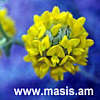 |
||||||||||||||||||||||||||||||||||
|
||||||||||||||||||||||||||||||||||
|
||||||||||||||||||||||||||||||||||
|
|||||||||||||||||||||||
 |
|||||||||||||||||||||||
| - | |||||||||||||||||||||||
|
||||
Pressure, Endangered Species and Hope (Source for "Pressure" is the 2000 report by the UNEP on Armenia's Biodiversity, and has not been independently confirmed) Pressure Over the last 50 years increased farming has resulted in the loss of natural grasslands and wetlands, while clear cutting forests has resulted in substantial losses in biodiversity. Habitat loss adversely affected resources and nesting for a range of species, with those restricted range species have been particularly affected. For example, the partial drainage of Lake Sevan to generate hydropower has dramatically decreased spawning areas for Sevan trout, a major food source for local bird species. Pollution There is a significant increase in pollution in recent years, factories have no real controls over the amount of emissions they can emit. In the name of job security and economic growth, the horrors of over-industrialization before the fall of the Soviet Union may not be so apparent, but they show signs of resuming unfettered pollution. They are still restricted to a few urban areas, but the balance between jobs and the future is a real challenge in Armenia's fragile ecosystem Climate change An impact of pollution on the natural environment is increasingly being proved to directly affect global warming. Increases of 2-3+ C (4-6+ F) are predicted for Armenia's climate. This equates to a decline in rainfall, resulting in increased risks of desertification. This is likely to severely affect wetland habitats and associated species, while changes in the distribution of habitats may affect the range and viability of a number of species. Pastures represent around half the agricultural land, and have been severely degraded by overgrazing. Over the last 70 years, there has been increased conversion of semi-desert, steppe and wetland habitats for cultivation, resulting in the loss of some important sites, and increased threats to species. Wetlands Far more serious is the immense loss of water in Lake Sevan and attempts to fix it. Since the 1930s the development of the economy relied on the water resources of the lake. Drainage of its waters supplied irrigation systems for agriculture and hydroelectric power stations downstream. Water from the lake irrigated around 100,000 hectares and generated more than 2.5 million kW of electricity, providing an important contribution to the development of the country. However, such extensive use also resulted in a serious ecological disaster, with significant falls in the level of the lake. Since 1933 the level of the lake fell by 19m, and its overall volume decreased by 42%. As a result the average temperature of the lake increased, oxygenation levels fell, resulting in eutrophication and algal blooms. The current attempt to save the lake is not alternative energy, but to drain mountain water in higher elevations using a pipe tunnel bored through the southern mountains. This will cause loss of water resources in alpine regions, and is a desperate attempt to delay the inevitable total loss of Armenia's surface water. It is calculated the loss can be complete in as soon as 50 years unless total reversal of questionable, still-Soviet planning is made. Governmental Jokes Endangered Species The Good News And there is time. The departure of up to 1 million people in the last ten years has had the unseen consequence of decreasing pressure on the environment, but as the economy improves, more pressure will come. The typical Armenian inside Armenia actually shows more understanding of the consequences of what they do then those in the Diaspora, which don't even have a record for conservation, let alone understanding. It will be up to local Armenians to repair and conserve, and they may just do it, despite pressure from even their own kind outside to do otherwise. EcoTourism is the greatest way to educate and give incentives to conserve, and the few Birding Associations involved in Armenia have gone a long way to prove this. Use any EcoTourism group and you will be directly supporting the people who fight for the country. Contact your country's foreign aid dept. or ministry and insist they give at least some money to active conservation of Armenia's lands and fauna, not commission yet another study. Contact your legislators and senators, and your embassy when in Armenia. Let them know you are here for the nature, and you want them to be wise to protect it, lest the problem of pollution and global warming become more severe in your country as a result.
The Birds In Armenia Project is the greatest advocate for conservation and the most knowledgeable sources about the impact of environment on Birds. They are the authors of the field guide, "The Birds of Armenia", the only printed source on this topic. They are also the only group working to exclusively conserve bird habitats. They offer tours and guided visits, for a fee. You can reach them in Yerevan by calling Dr. Martin Adamian or his assistants Levan and Luba at (Tel (3741) 151-413, 28-15-02).
BIRDING
WEB SITES ERMC
INDIVIDUAL
TRIP REPORTS GUIDES
/ TRIPS
|
| |
Search | |
||||||



![[Hawk]"](storypage/storyimages/uploaded43hawk.jpg)